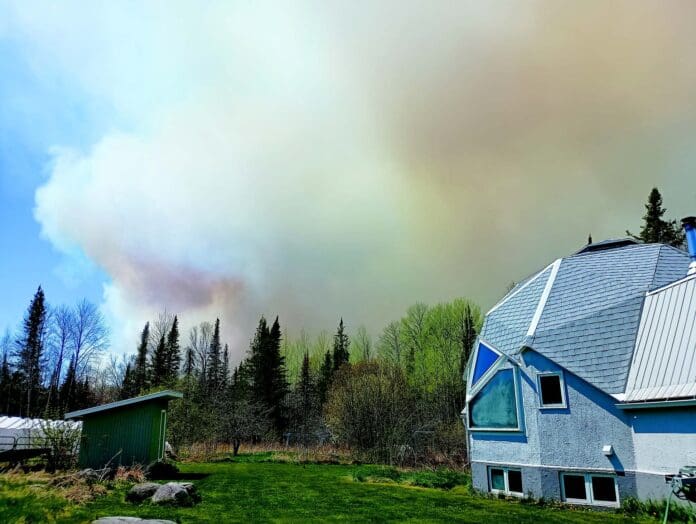When Dean Storm received a text at 2:01 PM on May 11 warning that a fire was traveling his way “fast” and urging him to “Get what you need ready and loaded in case,” he decided to get a better look—from a unique perspective.
Storm’s property includes a 120-foot tower, once used for a wind turbine. Climbing to the top for a clearer view, he saw smoke rising thickly in the distance.
The text came from someone near where the fire—dubbed the Camp House Fire after the nearby Lutheran camp—originated. The camp property, part of Green Lake Lutheran Ministries, borders Storm’s land.
Two hours later, he received another text that read:
“They are coming in at the treetops here — two copters, two jet belly dump planes, two float dump planes, one C-130, and three others, all dumping water and pink flame retardant.”
That afternoon, two Lake County sheriff’s deputies stopped by to record his phone number. Later, while driving to Toimi School after receiving an evacuation call from the county, he saw the deputies again as they posted evacuation notices on residents’ doors. Toimi School, a historic two-room schoolhouse built in 1914 by Finnish immigrants, is located at 6486 Murphy Lake Road in Brimson and serves as both a community center and a historical site.
Escaping with his two dogs and a pet Guinea fowl, Storm spent Sunday night at Toimi School where other evacuees had gathered. There, he visited with a man who had a cabin nearby and was vacationing with his family and dogs when they received the evacuation notice.
The next day, with his home inside a police perimeter, Storm returned to pack up more belongings and take pictures. He also climbed back up his tower, this time watching aircraft—water bombers and helicopters—fly overhead as they battled the fire.
“I was looking off in that direction, and it just scared me because I could see flames coming off the trees in the distance,” Storm said. “Probably not much farther than the camp, but I could see the fires burning high in the crowns of the trees.”
Later he added, “When I went up on the tower the day after the first fire started, I could see the fire off in the distance, the Jenkins Creek Fire. It was the same thing, burning higher up in the tops of the trees.”
Snapping pictures of the airplanes flying over his property from the tower as they fought the fires was a terrifying experience, one he described as “kind of dramatic” to see.
“Those pictures are probably the scariest things for me,” he said. “I’m not a terribly brave person, and when I could see the fire off in the distance, I would get dizzy. I don’t think I’d be a good fireman.”
He began packing more things but was interrupted by a knock on the door — this time from the Fire Department.
“They said it was time to get out of here,” Storm recalled. “They had people coming in, and I asked them if they thought my house had a chance. They said it did.”
Storm had spent the past year cutting down dead trees around his property—a “drop in the bucket” effort, he said, but one that improved his chances of survival. Before leaving, he took additional steps to protect his home.
“I left one sprinkler running behind at the house since I only had one working sprinkler,” he said. “I also used the garden hose to spray a mist over the front porch because those are dangerous areas.”
With nowhere else to go, he headed toward the campground on Sullivan Lake along Highway 15—only to find an evacuation notice warning that the area was within the danger zone.
“I drove a little further to where the deputies had set up a blockade. They told me that most of the road to Ely—and the campgrounds along it—were also closed because of the fire,” he said.
He asked a deputy if there was anywhere he might be able to go, and was directed to a gravel pit on the road to Ely.
“It turned out to be a really nice place to stop and stay,” Storm reported. “Other people have used that as a campground, and I can understand why.”
He stayed in his 1998 Dodge Ram truck, normally used for hauling firewood. “It had lots of wood chips and sawdust when me and the dogs moved into it,” Storm said. “But it was better than nothing.”
In an email exchange, Storm said simply, “There I stayed, until the rains came.”
Though his pump gave out after less than a day, cutting off the only sprinkler he had running, Storm was relieved to find that his house had withstood the fire.
At the time of this writing, the fire is at 98% containment. Evacuations have been lifted, but some roads in the Superior National Forest and recreation sites remain closed. The blaze grew to cover 12,071 acres and destroyed at least 144 structures in its path.
Authorities have confirmed that the Camp House Fire was caused by an unattended campfire on private land before spreading into the Superior National Forest. The Minnesota Department of Natural Resources (DNR) has identified the person involved, though their name has not been publicly released. The investigation is ongoing as officials determine potential consequences.
The Jenkins Creek Fire is now 95% contained after burning 16,089 acres. Damage assessments are ongoing, with several homes and cabins reported lost. The fire is suspected to have started from a discarded cigarette near Highway 16.
While the fires are largely contained, the threat of wildfires remains. Officials urge residents and visitors alike to stay vigilant, practice fire safety, and support ongoing efforts to protect Minnesota’s forests and communities from future disasters.
Special thanks to Dean Storm for sharing his experience and photos.



